The MSI Z170A Gaming M7 Review: The Step Up to Skylake
by Ian Cutress on September 21, 2015 12:30 PM EST- Posted in
- Motherboards
- Gaming
- MSI
- Skylake
- Z170
CPU Performance, Short Form
For our motherboard reviews, we use our shortform testing method. These tests usually focus on if a motherboard is using MultiCore Turbo (the feature used to have maximum turbo on at all times, giving a frequency advantage), or if there are slight gains to be had from tweaking the firmware. We leave the BIOS settings at default and memory at JEDEC (DDR4-2133 C15) for these tests, making it very easy to see which motherboards have MCT enabled by default.
Video Conversion – Handbrake v0.9.9: link
Handbrake is a media conversion tool that was initially designed to help DVD ISOs and Video CDs into more common video formats. The principle today is still the same, primarily as an output for H.264 + AAC/MP3 audio within an MKV container. We test two files, one with small frame sizes (640x266 24 FPS film running for 2h20) and one with super large frame sizes (double-UHD, 3840x4320 at 30 FPS animation short) to show where certain processor designs give better boosts for large frames which might not be obvious in small frame environments.
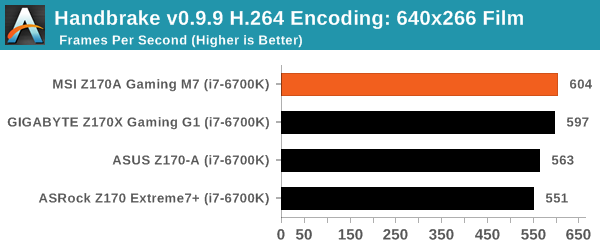
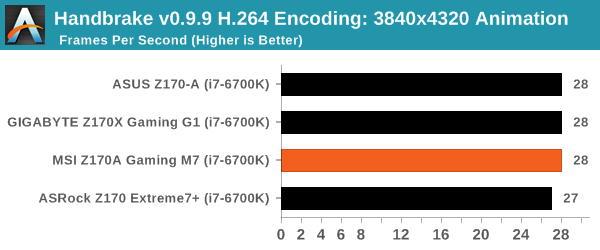
Compression – WinRAR 5.0.1: link
Our WinRAR test from 2013 is updated to the latest version of WinRAR at the start of 2014. We compress a set of 2867 files across 320 folders totaling 1.52 GB in size – 95% of these files are small typical website files, and the rest (90% of the size) are small 30 second 720p videos.

Point Calculations – 3D Movement Algorithm Test: link
3DPM is a self-penned benchmark, taking basic 3D movement algorithms used in Brownian Motion simulations and testing them for speed. High floating point performance, MHz and IPC wins in the single thread version, whereas the multithread version has to handle the threads and loves more cores. For a brief explanation of the platform agnostic coding behind this benchmark, see my forum post here.
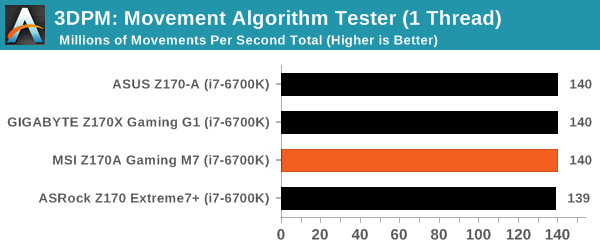
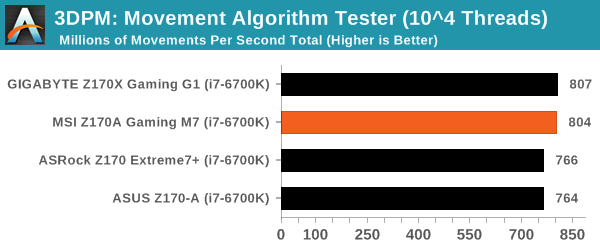
Image Manipulation – FastStone Image Viewer 4.9: link
FastStone is the program I use to perform quick or bulk actions on images, such as resizing, adjusting for color and cropping. In our test we take a series of 170 images in various sizes and formats and convert them all into 640x480 .gif files, maintaining the aspect ratio. FastStone does not use multithreading for this test, and thus single threaded performance is often the winner.
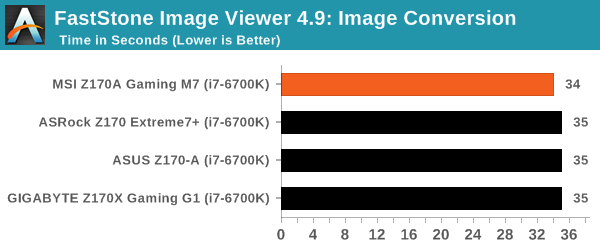
Rendering – POV-Ray 3.7: link
The Persistence of Vision RayTracer, or POV-Ray, is a freeware package for as the name suggests, ray tracing. It is a pure renderer, rather than modeling software, but the latest beta version contains a handy benchmark for stressing all processing threads on a platform. We have been using this test in motherboard reviews to test memory stability at various CPU speeds to good effect – if it passes the test, the IMC in the CPU is stable for a given CPU speed. As a CPU test, it runs for approximately 2-3 minutes on high end platforms.
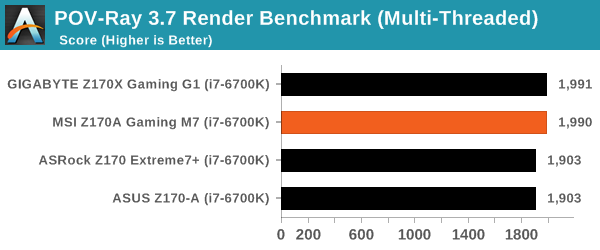
Synthetic – 7-Zip 9.2: link
As an open source compression tool, 7-Zip is a popular tool for making sets of files easier to handle and transfer. The software offers up its own benchmark, to which we report the result.
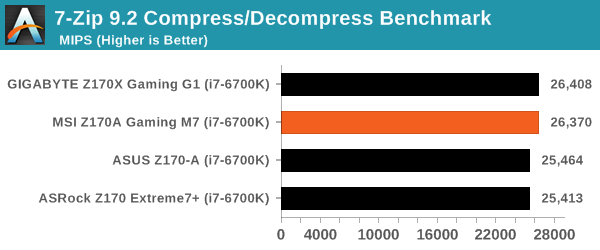










56 Comments
View All Comments
DanNeely - Tuesday, September 22, 2015 - link
I suspect the problem is that they ran out of high speed IO lanes for USB3 ports, didn't want to put 2.0 ports on (if they did someone else would be flaming them for doing so), and since this is a mid price board decided against using an onboard USB3 hub to add more ports. Having two x4 m.2 slots are probably to blame. The 1xx series chipset has a lot more IO than the 9x series that it replaced; but without using USB3 hubs or PLX chips it doesn't have enough to max out a full ATX board.prime2515103 - Monday, September 21, 2015 - link
This whole lack of HDMI 2.0 in PC's needed to end like a year ago.Ian Cutress - Monday, September 21, 2015 - link
HDMI is still not native to the Intel integrated graphics yet without a LS-PCon or Alpine Ridge (extra cost), but chances are with this motherboard that people will be using a discrete card. Pick a modern HDMI 2.0 capable one and you're set.Gigaplex - Monday, September 21, 2015 - link
Such as... the latest AMD Fury series? Still not supported. I think only Maxwell supports it so far. We need better support from the industry as a whole.artifex - Wednesday, September 23, 2015 - link
I thought the industry was moving to DisplayPort?DanNeely - Wednesday, September 23, 2015 - link
The PC industry is trying to move that way (in addition to a few minor technical advantages, to avoid paying HDMI royalties; a few cents/port adds up when you're making millions of something); consumer electronics and home theater are very HDMI oriented though, so we're probably stuck with it indefinitely too.ruthan - Monday, September 21, 2015 - link
eSata - is someone realy using this? External sata HDD connection woub be nice, but what about power for HDD, some USB to sata cable?Where is added value in comparision with usual Sata bracket connected to internal Sata port?
Few years ago seems, that this problem would solve eSataP - with included power but this standard died and we are still using USB3 to Sata bulky converters.
Gigaplex - Tuesday, September 22, 2015 - link
I use eSATA. My 3.5" enclosure is mains powered, and eSATA is much faster than USB 2.0.ppi - Monday, September 21, 2015 - link
Since I was considering this mobo, is it possible to:a) Disable Killer NIC prioritization; and
b) Disable Nahimic effects (no equallizer)?
Thanks.
K_Space - Monday, September 21, 2015 - link
I thought the number of lanes has not changed from what Haswell offers (?16 PCI-E 3.0)?Then excuse the noob question with regard to the 20 PCI lanes:
If you have CF running and an M.2 x4 PCI-E 3.0 SSD; can you be run 8x/8x for the CF and full x4 for the M.2 SSD?
The reason I ask is that I have an Extreme6 Z97 with a R9 295x2 on the first PCI-E 3.0 and an XP941 M.2 SSD in their UltraM.2 slot (also PCI-E 3.0). According to the AsRock manual (and CPU-Z confirms), the 295x2 is running @ x8, and the M.2 at x4. If I attempt to install another 295x2 (not that it is a good idea) I'm informed the second card would have to drop to x4 (8+4+4). Given that the 295x2 is dual GPU and linking through PCI-E, latency with x4 will probably not be ideal (I recall reading somewhere that up to x8 link speed won't hurt the 295x2 CF but anything lower might).
I may be confusing quite few concepts here so your patience and detailed explaination would be much appreciated!!